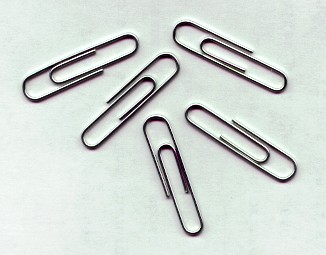Today, a look at the unfinished paper clip. The University of Houston's College of Engineering presents this series about the machines that make our civilization run, and the people whose ingenuity created them.
Some years ago, I sent a paper off to an editor. I happened to put it together with a paper clip I'd carried back from Jugoslavia. He was delighted. He collected paper clips. This was one he hadn't seen. After that, I found a different clip for everything I sent him. I never ran out of variations.
In this series we've seen that the true mother of invention is the creative pleasure it gives us. The vast variety of paper clips testifies to the pleasure they've given their inventors. Still, the paper clip did fulfill an old and nagging need.
Until this century we bundled papers with ribbon or string. If the sheaf was small enough, we used a straight pin -- even a clothespin. Engineer/historian Henry Petroski has looked into this problem. He finds a lot of late-19th-century experimentation but only one patent, from 1887. It was a soft metal clip you could bend into place to hold paper.
Now: pick up a modern paper clip and study its complex simplicity. It is a wondrous piece of compressed ingenuity. The Norwegian Johan Vaaler is usually called the inventor of the paper clip. Norway had no patent office, so he filed an American patent for a set of square and triangular clips.
That was in 1901. And maybe it was the first paper clip patent. But there's a catch. The fully evolved paper clip we use today showed up two years earlier in an 1899 patent. The catch is, it wasn't a paper-clip patent. Instead, William Middlebrook patented a machine that would make wire paper clips.
In one corner of his patent drawing is the clip his machine would make. It has the round top and bottom so familiar today. We call that the Gem paper clip because Middlebrook invented his machine for the Gem Company, in England.
Still, the Gem is only a compromise solution to a very hard problem. Consider the pitfalls waiting for a new paper clip. It should exert a clinging grip. It shouldn't tangle with other clips in a box. It should be easy to apply and remove. It shouldn't tear the paper or leave rust marks. It should be cheap and easy to make. Its use should be obvious.
One Gem clip maker said he got ten letters a month suggesting improvements. But people could improve one area only at the expense of another.
So the paper clip remains as a tantalizing exercise in elegance and sophistication. It dangles a lingering challenge. For this invention is not yet done. We still wait for the perfect paper clip. And who knows:
Maybe it is YOU who will, finally, give it to us.
I'm John Lienhard, at the University of Houston, where we're interested in the way inventive minds work.
(Theme music)
Petroski, H., The Evolution of Artifacts. American Scientist, Vol. 80, September/October 1992, pp. 416-420.
